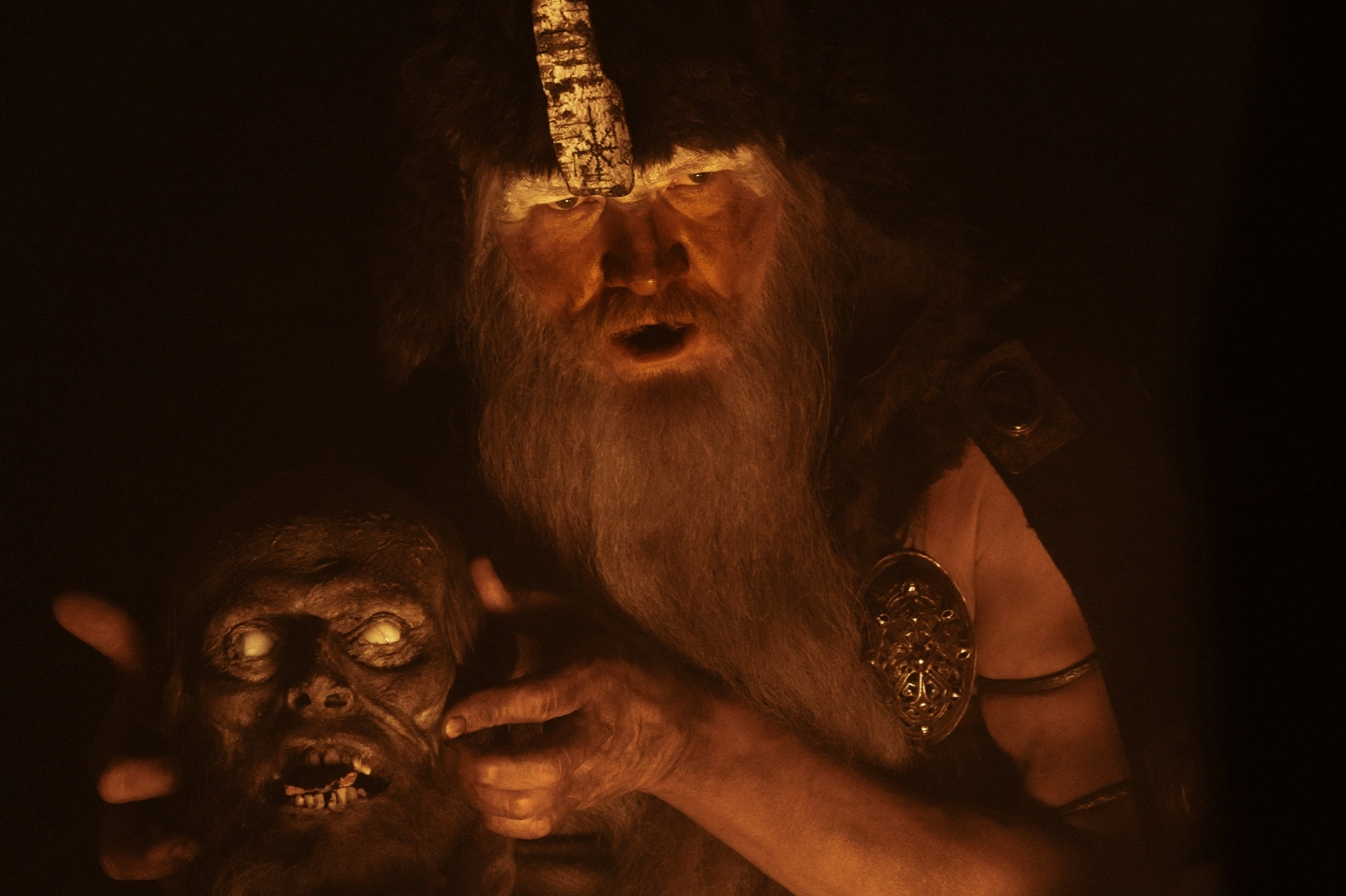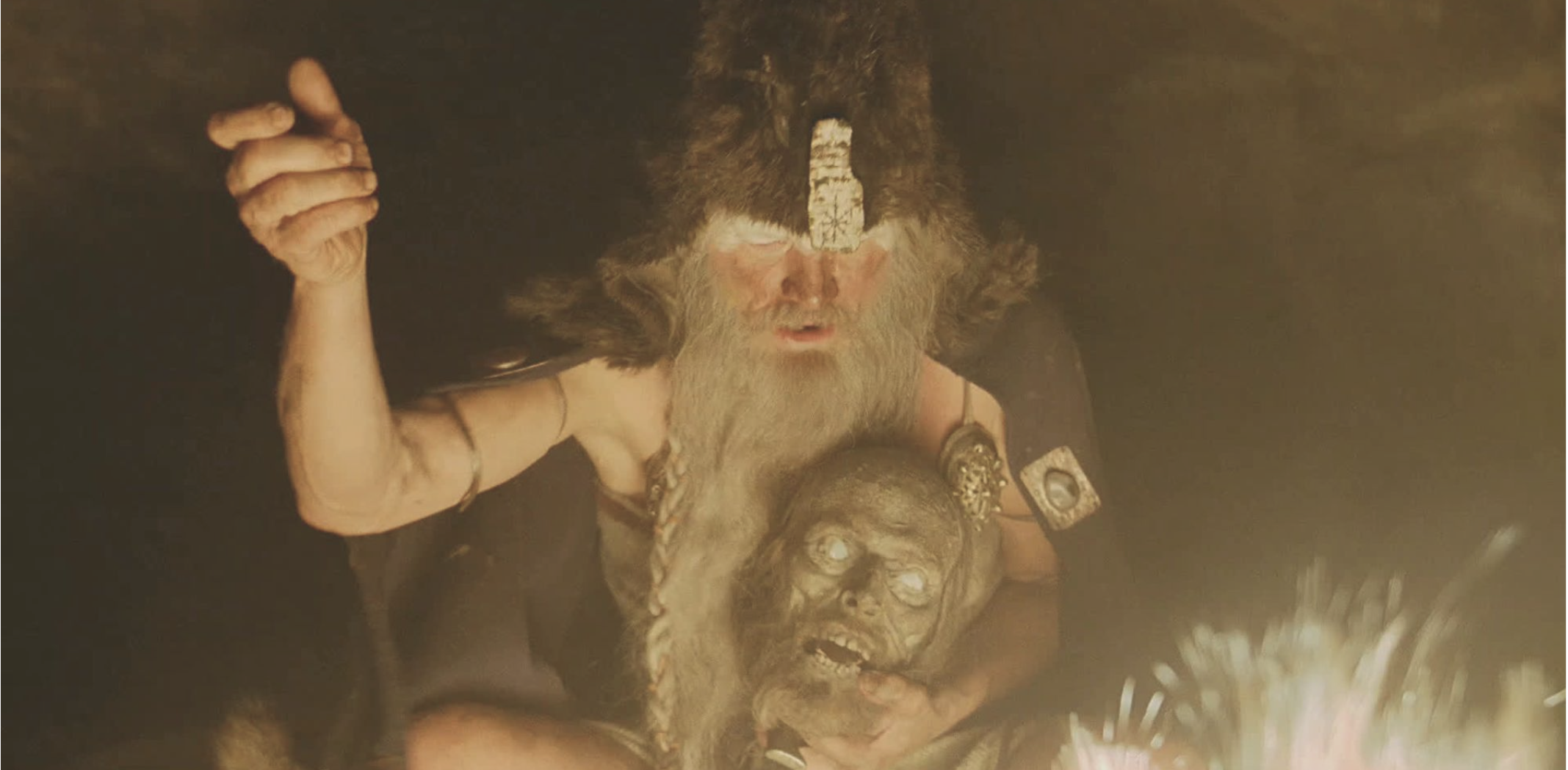
The He-Witch
Soon after Amleth travels to Iceland to seek revenge on his uncle, he meets a he-witch - also known as a galdramaður. Evidence of Galdramenn existing during the Viking Age is rare. During the Viking Age, strict gender roles dictated that men who practiced feminine activities (such as sorcery) were effeminate and they were typically ostracized from society (Gardeła 2008, 48). These ideas of gender and ostracism are well-represented in the movie, not just through the galdramaður’s use of magic and his isolated cave but through his costume as well.

The he-witch wears various accessories that show different parts of his identity. On his head, he wears a fur with a symbol hanging in the center of the forehead. The symbol is called Ægishjálmr (eye-gis-hyowl-mer) in old Norse, and “The Helm of Awe” in English. The Helm of Awe is first mentioned in “Fafnismol” from the Poetic Edda, when the dragon Fafnir explains he wore it as a form of protection (some English translations also call it the “fear-helm”). In “Fafnismol,” the helm is an actual, tangible helmet (”Fafnismol” 1936). But in manuscripts of Norse magic dating back to the 1500’s, the helm is a symbol painted usually on the forehead as a means of spiritual protection (”The Helm of Awe” 2021).

There’s little to no evidence that magic practitioners during the Viking Age used the Helm of Awe. That’s not to say it wasn’t used, just that the director and costume designer in The Northman took some creative agency here. I think it works well - those who are familiar with Norse mythology will probably catch it (and feel smart about it) and those who aren’t familiar will see it as an interesting detail.
Being a galdramaður during the Viking Age meant leaning into unconventional concepts of gender, like gender fluidity and androgyny. The costume designer Linda Muir perfectly displays the He-Witch’s identity as a fluid being through the use of accessories. Two specific pieces of jewelry stand out: the He-Witch’s arm bands, and the two brooches he wears over his chest.
We looked at arm rings a little bit with Amleth. Ibn Rusta detailed that Rus viking men wore arm rings, but archeological evidence suggests women did as well - though in Western society we see them as very masculine. In fact, University of Amsterdam Archeologist Andrea Pintar states that pieces of jewelry like arm rings have been found just as commonly in female graves as male ones, and they can’t be used to identify the sex of a Viking-Age gravesite (Pintar 2016, 4). By using something stereotypically masculine yet historically gender-neutral, the creative team of The Northman hint at unconventional gender identities existing during the Viking Age.
The He-Witch also wears womens brooches, which we looked at in Queen Gudrún’s page. Only women wore these brooches during the Viking-Age as they helped to hold up a woman’s dress. Even to someone unfamiliar with viking history, they look feminine and somewhat resemble a modern bra. Using something very obviously womanly for the He-Witch signifies his effeminacy as a man practicing magic during the Viking Age.
References
“Fafnismol” 1936. The Poetic Edda. Translated by Henry Adams Bellows. New York: Princeton University Press. https://www.sacred-texts.com/neu/poe/poe24.htm
Gardeła, Leszek. 2008. “Into Viking Minds: Reinterpreting the Staffs of Sorcery and Unravelling ‘Seiđr.’” Viking and Medieval Scandinavia 4: 45–84. http://www.jstor.org/stable/45093195.
Muir, Linda. 2022. “For ‘The Northman’ Costume Designer Linda Muir Undertook Epic Research” Interview by Christopher L. Inoa. Observer. https://observer.com/2022/04/for-the-northman-costume-designer-linda-muir-undertook-epic-research/
Pintar, Andrea. 2016. “Valkyries or Valiant Women: The World of Women, Weapons and War in Viking Age Scandinavia. A Lecture Review” ResearchGate. https://www.researchgate.net/publication/304540299_Valkyries_or_Valiant_Women_The_World_of_Women_Weapons_and_War_in_Viking_Age_Scandinavia_A_Lecture_Review
Sauber, Wolfgang. 2009. “Eiríksstaðir. Front of a Viking woman.” Wikipedia Commons. https://commons.wikimedia.org/wiki/File:Eiríksstaðir_-_Wikingerschmuck.jpg
sixleafsage. 2019. “Vegvisir and Helm of Awe tattoos done by Michaela at Iron Brush Tattoo, Lincoln, NE.” r/tattoos on Reddit. https://www.reddit.com/r/tattoos/comments/ch36wf/vegvisir_and_helm_of_awe_tattoos_done_by_michaela/
“The Helm of Awe” 2021. Nordic Culture. Skjalden.com. https://skjalden.com/helm-of-awe/
